In 2015, the American Musicological Society gave the Noah Greenberg Award to musicologist Jessie Ann Owens and the vocal ensemble Blue Heron, directed by Scott Metcalfe, for their project to produce the world premiere recording of Cipriano de Rore’s landmark I madrigali a cinque voci (Venice, 1542). The award, named for the founder of the New York Pro Musica Antiqua, encourages cooperation between scholars and performers and recognizes outstanding contributions to historical performing practices.
On May 3, 2018, Owens spoke at the Academy about Cipriano’s music; following her presentation, Blue Heron performed a selection of madrigals drawn from his 1542 publication. The program, which served as the Academy’s 2067th Stated Meeting, included a welcome from Jonathan F. Fanton (President of the American Academy) and an introduction by Jane A. Bernstein (Austin Fletcher Professor of Music Emerita at Tufts University). The following is an edited version of Jane Bernstein’s introduction and Jessie Ann Owens’s presentation.

Jane A. Bernstein
Jane A. Bernstein is the Austin Fletcher Professor of Music Emerita at Tufts University. She was elected a Fellow of the American Academy in 2005.
Introduction
It is a great honor for me to introduce this evening’s program: “Songs of Love and Death: Selections from Cipriano de Rore’s I madrigali a cinque voci of 1542.” I am particularly excited to do so because this event exemplifies a true collaboration between music scholarship and performance presented by my dear friend and colleague, Professor Jessie Ann Owens, and Boston’s premiere early music ensemble, Blue Heron.
Jessie Ann Owens is one of the foremost scholars of Renaissance music. She is Distinguished Professor Emeritus of Music and former Dean of the Humanities, Arts, and Cultural Studies at the University of California, Davis. She has had a long and outstanding career as a teacher, scholar, and administrator. Before coming to UC Davis, she taught at the Eastman School of Music and then at Brandeis University, where she served first as Dean of the College and then as Dean of Arts and Sciences. She also holds the distinction of serving as president of two scholarly societies: the American Musicological Society and the Renaissance Society of America.
Her research in the Renaissance has centered on the Este Court in mid sixteenth-century Ferrara, compositional process, the Italian madrigal, Elizabethan and Jacobean music treatises, and the music of Cipriano de Rore. Not known to shy away from challenging projects, Professor Owens served as editor of the monumental thirty-volume series The Sixteenth-Century Madrigal, which for the first time made available to performers literally thousands of Italian madrigals in modern score. She is also acclaimed for her pathbreaking book, Composers at Work: The Craft of Musical Composition 1450–1600, published by Oxford University Press, which received the 1998 ASCAP-Deems Taylor Award. In this highly original study, Owens tackles the question of how Renaissance musicians wrote their music, offering for the first time a systematic examination of composers’ autograph manuscripts before 1600. But it is her long and continuous work on the Flemish composer Cipriano de Rore and the madrigal that has led to her remarkable collaboration with Blue Heron.
The Italian madrigal is a unique musical/poetical genre, where, as the composer Mazzone de Miglionico in his 1569 First Book of Madrigals put it, “the notes are the body of music, but the words are the soul.” The vocal ensemble Blue Heron is the ideal partner for this important project, since under the leadership of Scott Metcalfe, the Boston-based group has been widely admired for its highly sensitive performances and its commitment to the understanding of the texts. Blue Heron has been praised by both music critics and scholars alike as one of the finest early music ensembles specializing in the Renaissance musical repertory.
Professor Owens’s and Blue Heron’s mission has been to bring to life again one of the most important works of the sixteenth century by creating the first recording of Cipriano de Rore’s first book of madrigals from 1542. For this exciting project, they have received the coveted Noah Greenberg Award from the American Musicological Society. Some of you may have heard of Noah Greenberg, who, in 1952, founded the New York Pro Musica, one of the first early music ensembles in North America, most famous for its revival of the great medieval masterpiece, The Play of Daniel. The Award, established by the Trustees of the New York Pro Musica Antiqua in memory of their first director, is intended as a grant-in-aid to stimulate active cooperation between scholars and performers by recognizing and fostering outstanding contributions to historical performing practices. What could be a more perfect project than this collaboration to produce a world premiere recording of Rore’s landmark madrigal edition.

Jessie Ann Owens
Jessie Ann Owens is Distinguished Professor Emeritus of Music at the University of California, Davis. She was elected a Fellow of the American Academy of Arts and Sciences in 2003.
It is becoming clear, thanks in part to the collaboration with Blue Heron, that Cipriano de Rore’s first book of madrigals is remarkable both for its unprecedented scale and for the intensity of its emotional journey. My thanks to the American Academy for giving me the opportunity to present these findings and to Blue Heron for their inspired and revelatory performances.
In 1542, a Flemish immigrant to Italy with no steady job that we know of burst onto the musical scene with a remarkable publication. Cupriaen De Rore, or Cipriano de Rore, as he signed his name in his letters, was twenty-seven years old, or possibly twenty-eight, and had never published any of his music when he brought out I madrigali a cinque voci with a leading Venetian music printer, Girolamo Scotto.
The title page of his 1542 publication is remarkably spare (see Figure 1). We learn nothing about the composer beyond his name – Cipriano Rore. We now think he may have been working as a freelance composer and living in Brescia, not far from Venice, when this book was published. Just a few years later, in 1546, he would secure the most prestigious post in Italy, chapelmaster for the Duke of Ferrara, so maybe this book functioned like a dissertation or a first book to advertise the composer’s skills to potential employers. He later served as chapelmaster at the Farnese court in Parma and then at San Marco in Venice. He returned to Parma and died there in 1565, at the age of forty-nine or fifty. The portrait in Figure 2, in a luxurious manuscript commissioned by Duke Albrecht V of Bavaria in 1559 and painted by court painter Hans Mielich, shows him at the height of his fame as a composer.
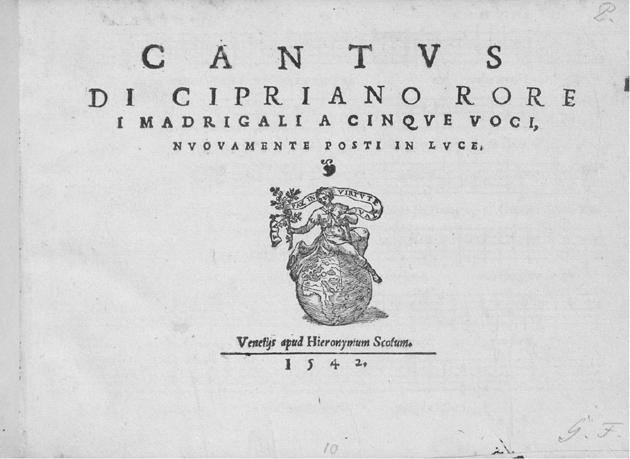 |
| Figure 1. Title page, Di Cipriano Rore i madrigali a cinque voci (Venice, 1542), Wien, Österreichische Nationalbibliothek, Musiksammlung, SA.77.D.5/1-5 (used by permission). |
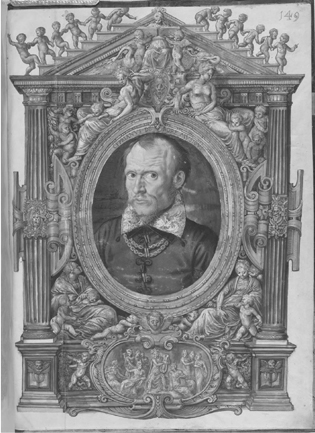 |
| Figure 2. Hans Mielich, portrait of Cipriano de Rore, 1559, Munich, Bavarian State Library, Mus.ms. B, p. 304 (used by permission). Creative Commons Attribution-NonCommercial- ShareAlike 4.0 International (CC BY-NC-SA 4.0). |
But there is more to be gleaned from the title page. “CANTUS” tells us that this is one of five separate volumes, or partbooks, one for each of the five voices. The singer with the highest voice sings the cantus, the top line. Each singer saw only his or her own part, much like the members of a string quartet today.
Then comes Cipriano’s name, “CIPRIANO RORE,” followed by a very brief title: “I madrigali a cinque voci,” the madrigals for five voices. Most prints that contain madrigals – musical settings of Italian poetry – were part of a series, with titles such as “first book of madrigals for four voices,” “second book,” etc. By calling it “the madrigals,” it is almost as though this would be his only book of madrigals. He would in fact go on to publish five books for five voices and two books for four voices. The title page ends with the conventional “nuovamente posti in luce,” newly published, and information about the publication: the printer’s mark, the printer, and place and year of publication.
Equally interesting is what is not present. The book lacks a privilege, a form of copyright protection granted by the Venetian government that is typically printed on the title page: “cum gratia et privilegio.” The image in Figure 3 shows the title page of his 1545 book of motets, for which he did obtain a privilege. Did he not understand in 1542 the value of a privilege for protecting his intellectual property and creative work? Or did he lack the means for filing an application? The 1542 book became a best-seller, and four different printers brought out nearly a dozen editions over the course of the century.
Most striking is the absence of a dedication, the customary way of thanking a patron for financial support. The verso of the title page, where a dedication would typically be placed, has been left blank. Does this mean that Cipriano paid for the first edition of the book himself? Or was there possibly a patron who preferred to remain unnamed? Cipriano, unlike many composers, would never play the dedication game (trading a dedication for a subvention), and he never dedicated any of his prints to a patron.
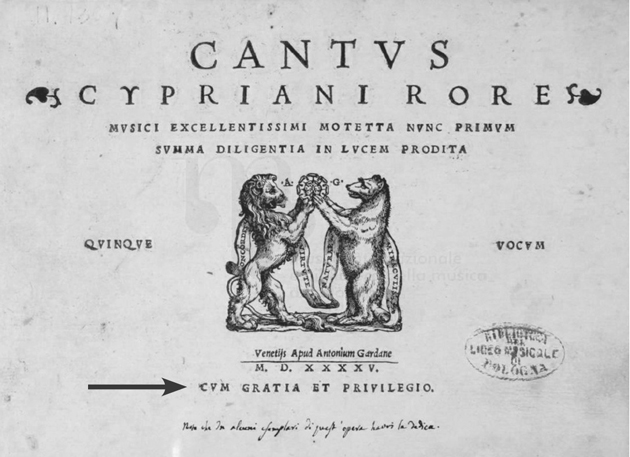 |
| Figure 3. Title page, Cypriani Rore motetta nunc primum summa diligentia in lucem prodita. Quinque vocem (Venice, 1545), Wien, Österreichische Nationalbibliothek, Musiksammlung, SA.77.D.32/1-5. Harald Fischer Verlag Online Collection “Die Musikdrucke der Staats- und Stadtbibliothek Augsburg 1488–1630” (used by permission). |
At the very end of the 1542 I madrigali a cinque voci is the table of contents (see Figure 4), a simple list of the twenty pieces in alphabetical order, most with the notation “con la seconda parte” (indicating a madrigal divided into two sections). Nothing draws attention to the special character of the contents. In fact, this print marked a significant change in the kinds of Italian texts composers were setting, away from lighter and shorter texts to serious texts drawn above all from the Rerum vulgarium fragmenta, or Canzoniere, the collection of 366 lyric poems by Francesco Petrarca (1304–1374), known in English as Petrarch (see Table 1). Sixteen of the twenty madrigals in the 1542 book are sonnets, the first time the sonnet would so dominate a publication, and twelve of them are by Petrarch. This publication marked a decisive turn toward the unparalleled popularity of Petrarch among composers in the middle decades of the sixteenth century.
Table 1: Contents of Cipriano de Rore, I madrigali a cinque voci (1542)
| No. First line | Poet | Form | Mode | Type (Key) |
| 1 Cantai, mentre ch’i arsi del mio foco | Brevio | 14-line ballata | 1 tr. | ♭ g2c2c3c3F3 G |
| 2 Or che’l ciel et la terra e’l vento tace | Petrarch 164 | sonnet | 1 tr. | ♭ g2c2c3c3F3 G |
| 3 Poggiand’al ciel coll’ali del desio | anon | sonnet | 1 tr. | ♭ g2c2c3c3F3 G |
| 4 Quand’io son tutto volto in quella parte | Petrarch 18 | sonnet | 2 tr. | ♭ c1c3c4c4F4 GG |
| 5 Solea lontana, in sonno consolarme | Petrarch 250 | sonnet | 2 tr. | ♭ c1c3c4c4F4 GG |
| 6 Altiero sasso, lo cui gioco spira | Molza | sonnet | 3 | - c1c3c4c4F4 E |
| 7 Strane rupi, aspri monti, alte tremanti | Amanio | sonnet | 3 | - c1c3c4c4F4 E |
| 8 La vita fugge et non s’arresta un’ora | Petrarch 272 | sonnet | 3 | - c1c3c4c4F4 E |
| 9 Tu piangi et quella per chi fai tal pianto | Tebaldeo | sonnet | 4 | - c2c4c4F3F4 EE |
| 10 Il mal mi preme et mi spaventa il peggio | Petrarch 244 | sonnet | 5 | ♭ g2c2c3c3F3 F |
| 11 Per mezz’i boschi inospiti e selvaggi | Petrarch 176 | sonnet | 5 | ♭ g2c2c3c3F3 F |
| 12 Quanto più m’avvicino al giorno estremo | Petrarch 32 | sonnet | 6 | ♭ c1c3c4c4F4 FF |
| 13 Perseguendomi amor al luogo usato | Petrarch 110 | sonnet | 6 | ♭ c1c3c4c4F4 FF |
| 14 Chi vol veder quantunque pò natura | Petrarch 248 | sonnet | 7 | - g2c2c3c3F3 G |
| 15 Quel sempre acerbo et onorato giorno | Petrarch 157 | sonnet | 7 | - g2c2c3c3F3 G |
| 16 Far potess’io vendetta di colei | Petrarch 256 | sonnet | 8 | - c1c3c4c4F4 GG |
| 17 Amor, che vedi ogni pensiero aperto | Petrarch 163 | sonnet | 8 | - c1c3c4c4F4 GG |
| 18 Ben si conviene a voi | anon | 9-line madrigal | [1] | ♭ g2c2c3c3F3 D |
| 19 Or che l’aria et la terra | anon | 11-line madrigal | [2 tr.] | ♭ c1c3c4c4F4 GG |
| 20 Da quei bei lumi ond’io sempre sospiro | Brevio | 13-line ballata | [3] | - c1c3c4c4F4 E |
| Note: ♭/- indicates the presence or absence of a flat in the signature; g2c2, etc., refers to the kind of clef and its placement on the staff; and the capital letter refers to the sonority of the final chord (a double letter refers to the lower octave). |
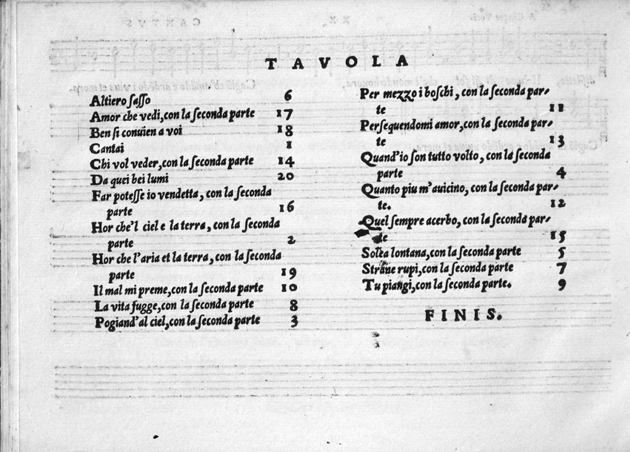 |
| Figure 4. Table of contents, Di Cipriano Rore i madrigali a cinque voci (Venice, 1542), Wien, Österreichische Nationalbibliothek, Musiksammlung, SA.77.D.5/1-5 (used by permission). |
Stylistically, the music made a comparable shift: from the relatively simple chanson-like style of the early madrigal, typically for four voices, to a highly wrought setting that used imitative polyphony of the sort more commonly found in motets, usually for five voices. These are long pieces, mostly in two sections (usually with the first eight lines of the sonnet in the first, the last six in the second), written in the new “black note” rhythmic notation. It is no exaggeration to say that with this print De Rore established the madrigal as a genre that would celebrate the fusion of music and poetry.
Other features of this publication have revealed themselves only gradually. Cipriano chose to compose and organize the music in the order of the modes, a kind of predecessor of keys in later music, from mode 1 to mode 8 (see Table 1). Only the final three pieces in the book do not adhere to this scheme. He distinguished between the pairs of modes – 1 and 2, 3 and 4, and so forth – through range: the contrast between high and low shown by the choice of clefs (the high g2 versus the low c1).
This is the earliest collection of polyphonic music to use modal order, first recognized by Bernhard Meier in 1963 and remarked on by many scholars since then. In fact, Cipriano seems to have been among the first composers to understand how to translate the concepts associated with modality, devised originally for monophonic chant, for polyphonic music. The models he established would be followed by composers such as Palestrina and Lasso for the rest of the century.
Until now, however, no one has asked the why question: why would Cipriano decide to compose and organize this collection according to the eight modes? The answer gets at the heart of why this is such an important print. I believe that the texts form a previously unrecognized cycle of sixteen sonnets, a sequence that tells a story through words and – this is the crucial point – also through music by using modes to bring out the affect of the text.
The print divides into four large groups, with pieces ending on G, then E, then F, and then G again (the final three pieces stand outside this scheme). These groups can be seen as an orderly and logical series of moves through four scale types or sounds, each with a distinctive ordering of whole and half steps:
G with a flat (D transposed up a fourth)
E
F with a flat
G
We can rearrange these four scale types or characteristic sounds along a continuum from the most minor sound, E phrygian, with its distinctive half-step opening, to the very bright F major, a continuum from darker to lighter:
Darker (E)
Dark (G with a flat)
Light (G)
Lighter (F with a flat)
If we then arrange the groups as they appear in the print, we see the audible effect of this grouping:
Dark (G with a flat)
Darker (E)
Lighter (F with a flat)
Light (G)
The first half is in the minor modes (using the dorian and phrygian scales on D [transposed to G with a flat] and E), and the second in the major modes (using the lydian and mixolydian scales on F and G). This large-scale tonal structure reflects the narrative arc of the cycle, which moves from the darkness of love’s pain and loss in the first half to resignation and acceptance in the second.
At the very center is Tu piangi et quella per chi fai tal pianto, the only piece to end on low E (EE), which serves as a pivot between the two halves:
Il viver nostro è un fior colto de spina;
però piangi la tua, non la sua morte,
ché morte è quella che se chiama vita.
(Tebaldeo, 1989 ed.)
Our life is a flower grown from a thorn;
so weep for your death, not for hers,
for death is that which is called life.
(trans. Lloyd/rev. Owens)
Death and life are juxtaposed.
The book opens with a ballata by an unnamed poet that functions like a proem or introduction to the sonnet sequence, highlighting themes that would recur throughout the cycle. From the 1545 publication Rime et prose volgari di M. Giovanni Brevio we learn that the poet was Giovanni Brevio (ca. 1480–ca. 1560), a Venetian priest and novelist. He wrote both the opening ballata and the one that closes the book. His presence in these important positions in I madrigali could well function as a poetic signature. We know little about his life: nephew of a cardinal (by adoption), he spent time during the 1510s in Rome and again in the 1540s, and held ecclesiastical benefices in the Veneto. He lived in Padua and Venice and was friends with many of Italy’s leading writers. Although no portrait has survived, we do have his coat of arms, showing crossed lion’s paws (see Figure 5).
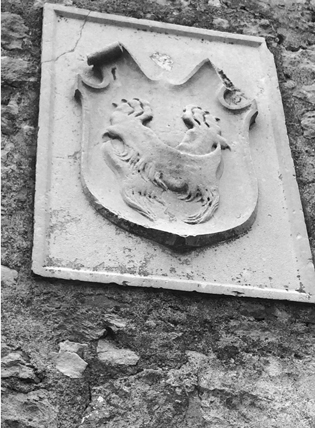 |
| Figure 5. Giovanni Brevio, coat of arms, Arquà Petrarca (photo: Owens). |
We will never know for sure, but it seems very likely that Brevio collaborated with De Rore to assemble this set of texts, mostly by Petrarch but also by contemporary imitators of Petrarch, and to organize them in such a way as to create a narrative that can be expressed through the affects of the modes. I do not have time to make a detailed case for reading these texts as a cycle, but I can draw attention, by way of example, to links among the four darkest texts, those set to the E mode. Altiero sasso and Strane rupi both concern the natural world (words for rocks and cliffs – rupi, sassi, pietre – recur several times). In Strane rupi, La vita fugge, and Tu piangi there are repeated references to sadness – the sad heart (twice), the sad fate – and no fewer than six references to weeping. Similar kinds of connections run throughout the cycle.
I will be the first to admit that the evidence of a collaboration is circumstantial. But it is significant that I can tie Brevio, directly or indirectly, to all of the poets whose texts make up the 1542 print. Pride of place, of course, goes to Petrarch. Brevio is known to have owned two early sixteenth-century prints of Petrarch’s Canzoniere, one of which survives today in Florence. It is a heavily annotated copy, in which he traces Petrarch’s quotations and allusions. Brevio knew his Petrarch inside and out. He also shared with his friend Pietro Bembo (1470–1547), cardinal, poet, and influential literary critic, a fascination with fourteenth- and fifteenth-century manuscripts of the tre corone – Dante, Boccaccio, and Petrarch – and owned a now-lost manuscript copy of the Raccolta Bartoliana, a collection of medieval lyric poetry.
Antonio Tebaldeo (1463–1537) was a well-known poet and courtier, associated with the courts in Mantua and Ferara. He then moved to Rome, and as a member of the circle around Pope Leo X could well have known Brevio. Brevio copied and annotated Tebaldeo’s poetry in a manuscript anthology that I believe he compiled, which is preserved today in Venice. Tebaldeo’s sonnet Tu piangi, the oldest poem in the 1542 collection, apart from Petrarch’s, was published in 1498 and many times thereafter.
Niccolò Amanio (ca. 1468–ca. 1528), a lawyer and administrator as well as a poet, died without publishing his rime. They circulated in manuscript and then, from 1545, began to appear in printed anthologies published by the Venetian printer Gabriel Giolito di Ferrari. Brevio knew Giolito and could have been involved in that venture, which also included some of his own poems.
Perhaps the best documented connection is between Brevio and the poet and bon vivant Francesco Maria Molza (1489 – 1544). Not only did they overlap in Rome, where Molza lived for most of his life in the entourage of Medici prelates (Pope Leo X, Pope Clement VII, Cardinal Ippolito de’ Medici), but they certainly knew one another. A wonderful letter from the Florentine historian and letterato Benedetto Varchi to Molza describes his visit to Catajo in 1536, the villa south of Padua where the Italian noblewoman Beatrice Pia degli Obizzi held a literary salon. Varchi had a canzone by Molza that he recited by heart to Bembo and then brought with him in written form to Catajo. Beatrice was not there but Brevio was. Varchi writes:
La mattina seguente, vedete che particolari io conto perché vostra signoria intenda ogni cosa, andando presso ad Arquà per visitare la Cavagliera de gli Obizi [Beatrice Pia degli Obizzi], gliela presentai scritta, sendovi solamente monsignor Brevio, ed egli or forte, e or piano, e or cantando, la lesse tutta più di vinti volte sempre lodandola; all’ultimo mi disse alcune cose di non molta importanza, come vedrà vostra signoria, e io, dubitando di non tenerle a mente e per non errare, gliela riportai a casa, perché egli umanissimamente, presa la penna, scrisse di sua mano quello che vedrà vostra signoria. Quelli segni o freghi sono dove sua signoria vorrebbe si mutasse, né allora gli sovveniva come; né m’accade dire altro circa la canzone, salvo che ringraziar vostra signoria da sua parte d’aver mandato a mostrargliela, che certo intende e parla di vostra signoria come ella merita e mostra amarla cordialissimamente . . . . (ed. Bramanti, 2008)
The translation of the passage in bold is as follows: “I [Varchi] presented it to him [Brevio] in writing, and he read it more than twenty times, now loudly, now softly, and now singing it, always praising it.” Brevio then took the poem home with him and annotated it with editorial advice for Molza, whom he professed “to love most cordially.”
Molza’s sonnet in the 1542 print, Altiero sasso, is a strange text that has resisted interpretation:
Proud rock whose yoke breathes the ancient honor of the great people of Mars; river that breaks this way and that, now quiet and still, now full of rage and fury; slopes that all the world still loves and desires; eternal memories consecrated by so many and such writings; and you, scattered relics, on which every good soul gazes with devotion – I seem to hear fleeing around you the waves sighing, and the branches, and the flowers, and the breeze lamenting, and the stones breaking from grief, because already the day of weeping draws near when the beautiful face that all of Italy honors, will leave you, wrapped in horror at her departure. (trans. Feldman/rev. Owens)
The first section is clearly a reference to Rome, to the Capitoline and the Tiber. The natural world laments “because the day of weeping draws near when the beautiful face that all of Italy honors will leave you,” i.e., Rome, “wrapped in horror at her departure.” Who is this “bel viso,” the lady whose departure all of Italy mourns? A recent publication by Franco Pignatti has identified the context: the sonnet was written by Molza when it seemed that the “bel viso,” namely, Vittoria Farnese (shown in Figure 6 in a portrait by Jacopino del Conte), the niece of Pope Paul III and a very valuable property in the marriage diplomacy that was a constant in European politics, was set to depart for France to marry a member of the French royal family, François, duc d’Aumale. The negotiations failed, however; he would go on to marry Anna d’Este and she Guidubaldo della Rovere. The sonnet thus has a firm terminus ante quem of Spring 1541, after which it lost its original purpose and was in effect useless, except perhaps to Giovanni Brevio, who could imagine putting it into the group of sad texts that De Rore could set in the mournful phrygian mode. We have to imagine a manuscript circulation of the sonnet, perhaps between Molza and Brevio. Cipriano likely encountered the text after Spring 1541, possibly in 1542, setting it as part of the cycle.
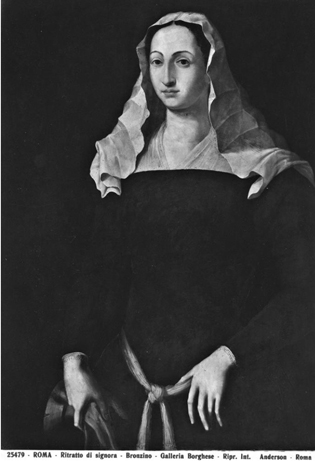 |
| Figure 6. Jacopino del Conte, portrait of Vittoria Farnese (1550–1560, Image date: 1930), Galleria Borghese, Roma, http://library.artstor.org/asset/AZERIIG_10312611818. Web. 2 Jul 2018. Artstor. |
But how did De Rore and Brevio connect? My best guess is through Count Fortunato Martinengo, who Bonnie Blackburn argues may have been De Rore’s patron in the early 1540s. The count can be documented in Padua, as part of the circle around the newly formed Accademia degli Infiammati. A letter from 1540 suggests that Brevio would be invited to join; he was living in Padua, just down the street from Sperone Speroni, who in 1541 would become Prince of the academy.
Unfortunately, we have no evidence of performances of the 1542 madrigals during the sixteenth century, and so we do not know whether they were intended to be sung as a set or in smaller groups or individually, or in all of these different ways. The scale is monumental by Renaissance standards, in which most pieces lasted only a few minutes. The scale is also monumental by today’s standards, which is why Blue Heron is focusing this year on half of the pieces, and next year on the other half. (The two-CD set will be issued in 2019.)
Let me close by considering one of the pieces Blue Heron will perform: Amor, che vedi, the Petrarch sonnet that closes the cycle. The cycle had opened with the poet-narrator setting forth two protagonists: Madonna, his lady, and Amor, the vengeful god who drove his pain:
Cantai, mentre ch’i’ arsi del mio foco
la viva fiamma ov’io morendo vissi,
ben che quant’io cantai e quant’io scrissi
di madonna e d’amor, fu nulla o poco.
I sang, while I burned from the living
flame of my fire where I dying lived,
although what I sang and wrote about
my Lady and about Amor was nothing
or little. (trans. Owens)
Amor, or Cupid, makes periodic appearances over the course of the cycle, and in the closing poem is addressed directly:
Amor, che vedi ogni pensero aperto
e i duri passi onde tu sol mi scorgi,
nel fondo del mio cor gli occhi tuoi porgi
a te palese, a tutt’altri coverto.
Sai quel che per seguirte ò già sofferto,
et tu pur via di poggio in poggio sorgi
di giorno in giorno, et di me non t’accorgi.
che son sì stanco, e ’l sentier m’è troppo erto.
Ben veggio io di lontano il dolce lume
ove per aspre vie mi sproni et giri,
ma non ò come tu da volar piume.
Assai contenti lasci i miei desiri
pur che ben desiando i’ mi consume
né le dispiaccia che per lei sospiri.
(Petrarch, RVF 163, ed. Durling)
Love, you who see openly my every
thought and the harsh steps where you
alone guide me, reach your eyes to the
depths of my heart, which appears to
you but is hidden from all others.
You know what I have suffered in
following you; and still day by day you
climb from mountain to mountain,
and pay no attention to me who am so
weary, and the path is too steep for me.
I do see from afar the sweet light
toward which you spur and turn me
through these hard ways; but I do not
have wings, as you do, to be able to fly.
You leave my desires content as
long as I am consumed with a high love [desiring
well] and it does not displease her
that I sigh for her. (trans. Durling)
The overall affect of the text reflects acceptance, and the eighth mode can readily reflect that affect. The poet/narrator tells Cupid that he is tired, that Cupid knows how much he has suffered on the journey. The closing lines explain that he is content because he is consumed by loving and because his sighs are not displeasing to his lady. His beloved takes pleasure in his misery.
While working within the overall affect, Cipriano also brought out specific images (highlighted in bold) by means of vivid musical gestures. He set “i duri passi,” the harsh steps, as a descending tetrachord at different pitch levels or steps. At the lover’s utter exhaustion (“che son sì stanco”), he introduced a B flat, which sounds like a lowering of the key, a graphic illustration of the lover beaten down by his journey. At the end of the first part he represented the text, “and the path is too steep for me,” by employing a deliberate violation of the expectations for mode 8: he ends on D rather than on the more typical C, a subtle reference to the text; D is literally too steep or high for a plagal or low-range piece. In the second part, the lover continues to talk about “aspre vie,” the hard way or path, and now De Rore introduced sharps that are foreign to the mode to denote harshness. At the very end, he illustrated the lover’s sighs (“sospiri”) with rests. This gesture would become so common that there is scarcely a madrigal that does not depict “sospiri” with rests. These kinds of musical strategies invite the listener to savor the text and to be alert to specific musical responses.
The revelation of Cipriano’s 1542 publication – the novelty that must have come as a shock to listeners accustomed to simple settings of amorous texts – is the power of music to portray human emotion. These madrigals, each one a world unto itself, when taken together tell a story about the many faces of love. Quite an achievement for a first book.
Acknowledgments
This paper is drawn from a book in progress, Cipriano and the Search for Music Drama. I acknowledge with gratitude support from Villa I Tatti, the Harvard University Center for Italian Renaissance Studies, and the Gladys Krieble Delmas Foundation.
For Further Reading
On Cipriano’s early years in Italy, see Bonnie Blackburn, “Cipriano de Rore’s Early Years: The Brescian Connection,” in Cipriano de Rore: New Perspectives on His Life and Music, ed. Jessie Ann Owens and Katelijne Schiltz (Turnhout, 2016).
On Cipriano’s portrait and his connection with the Munich court, see Jessie Ann Owens, “Cipriano de Rore’s New Year’s Gift for Albrecht V of Bavaria: A New Interpretation,” in Die Münchner Hofkapelle des 16. Jahrhunderts im Europäischen Kontext, ed. Theodor Göllner and Bernhold Schmid (Munich, 2006).
On mode, see Bernhard Meier, The Modes of Classical Vocal Polyphony, trans. Ellen Beebe (New York, 1988); Jessie Ann Owens, “Mode in the Madrigals of Cipriano de Rore,” in Altro Polo. Essays on Italian Music of the Cinquecento, ed. Richard Charteris (Sydney, 1990); and Cristle Collins Judd, “Renaissance Modal Theory: Theoretical, Compositional, and Editorial Perspectives,” in The Cambridge History of Western Music Theory, ed. Thomas Christensen (Cambridge, 2002).
On the early editions of the 1542 book, see Massimo Ossi, “Petrarchan Discourses and Corporate Authorship in Cipriano de Rore’s First Book of Five-Voice Madrigals (Venice, 1542 – 44),” in Cipriano de Rore: New Perspectives on His Life and Music, ed. Jessie Ann Owens and Katelijne Schiltz (Turnhout, 2016).
On the madrigal in Venice, see Martha Feldman, City Culture and the Madrigal at Venice (Berkeley, 1995).
On the printer Girolamo Scotto and printing in Venice, see Jane Bernstein, Music Printing in Renaissance Venice: The Scotto Press, 1539–1572 (New York, 1998).
On the context for Molza’s sonnet, see Franco Pignatti, “Per l’edizione critica delle rime di Francesco Maria Molza. Il Casanatense 2667 e L’ambrosiano Trotti 431,” in Lettura e edizione di testi italiani (secc. XIII-XX), ed. Massimo Danzi (Lecce, 2014).
© 2018 by Jane A. Bernstein and Jessie Ann Owens, respectively